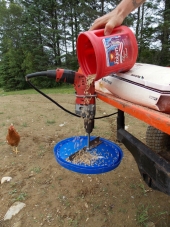Been living on rain water for some time. Over the years I've had various tanks ranging from the current 2 stainless steel 26,000 L tanks to a 32,500 L grey plastic tank. Never had an issue with algae. There are usually two filters and a first flush mechanism. The rain passes through the first filter, similar to the one shown in your pic, which is principally a leaf and other largish debris catcher, then it passes into the first flush mechanism, basically a large tube which can be emptied when needed, and finally at the entrance to the tank itself, is a another stainless steel filter, fine enough to keep mosquitoes out. Same size mesh is on the overflow outlet. Rain water tanks are common here and many rural folk live entirely on rain water they collect from their roof.
Just FYI, we have another 26,000 L tank for the shed which is currently under construction. When completed, we'll have a tank capacity of 78,000 L (a bit over 20,000 gal).








